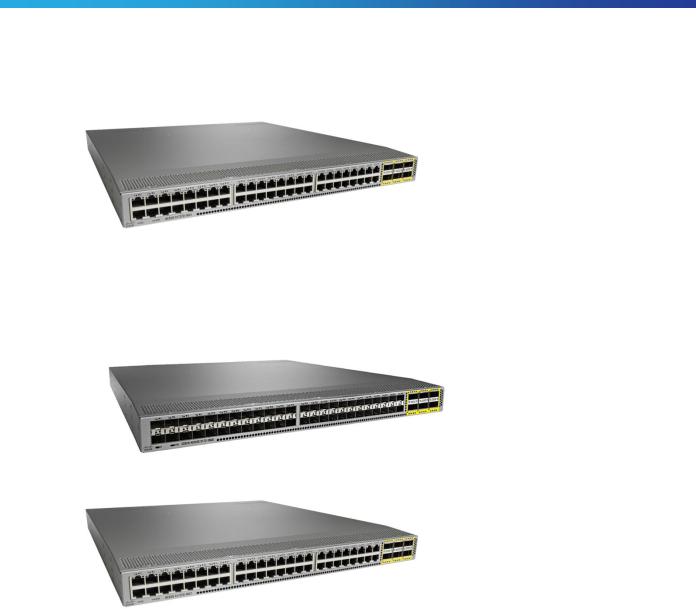Cisco Nexus 3172PQ, Nexus 3172TQ, Nexus 3172TQ-32T, Nexus 3172PQ-XL, Nexus 3172TQ-XL User Manual

Data Sheet
Cisco Nexus 3172PQ, 3172TQ, 3172TQ-32T,
3172PQ-XL, and 3172TQ-XL Switches
Product Overview
The Cisco Nexus® 3172PQ, 3172TQ, 3172TQ-32T, 3172PQ-XL, and 3172TQ-XL Switches are dense, highperformance, 10and 40-Gbps Layer 2 and 3 switches that are members of the Cisco Nexus 3100 switch platform. All switches offer improved port density and scalability in compact one-rack-unit (1RU) form factors. The Cisco Nexus 3172 switches run the industry-leading Cisco® NX-OS Software operating system, which helps ensure continuous availability and sets the standard for mission-critical data center environments. They are well suited for data centers that require cost-effective, power-efficient line-rate Layer 2 and 3 top-of-rack (ToR) switches. These switches also support forward and reverse airflow (port-side exhaust and port-side intake) schemes with AC and DC power inputs.
Five Cisco Nexus 3172 switches are available:
●The Cisco Nexus 3172PQ (Figure 1) is a 10-Gbps Enhanced Small Form-Factor Pluggable (SFP+)–based ToR switch with 48 SFP+ ports and 6 Quad SFP+ (QSFP+) ports. Each SFP+ port can operate in 100Mbps, 1-Gbps, or 10-Gbps mode, and each QSFP+ port can operate in native 40-Gbps or 4 x 10-Gbps mode. This switch is a true phy-less switch that is optimized for low latency and low power consumption.
Figure 1. Cisco Nexus 3172PQ Switch
●The Cisco Nexus 3172TQ (Figure 2) is a 10GBASE-T switch with 48 10GBASE-T ports and 6 QSFP+ ports. This switch is well suited for customers who want to reuse existing copper cabling while migrating from 1- Gbps to 10-Gbps servers.
●The Cisco Nexus 3172TQ-32T (Figure 2): This switch is the Cisco Nexus 3172TQ with 32 10GBASE-T ports and 6 QSFP+ ports enabled. The ports are enabled through software licensing. This switch provides a cost-effective solution for customers who require up to 32 10GBASE-T ports per rack. This switch comes with a 32-10GBASE-T port license preinstalled. To enable the remaining 16 10GBASE-T ports, the customer installs the 16-port upgrade license.
© 2016 Cisco and/or its affiliates. All rights reserved. This document is Cisco Public Information. |
Page 1 of 15 |

Figure 2. Cisco Nexus 3172TQ and 3172TQ-32T Switch
●The Cisco Nexus 3172PQ-XL (Figure 3) and Cisco Nexus 3172TQ-XL (Figure 4) are minor hardware revisions of the Cisco Nexus 3172PQ and 3172TQ, respectively. Enhancements include an additional 4 GB of memory (for a total of 8 GB). The additional memory allows users to perform object-model programming. The Cisco Nexus 3172PQ-XL and 3172TQ-XL also have 2.5-GHz CPUs.
Figure 3. Cisco Nexus 3172PQ-XL Switch
Figure 4. Cisco Nexus 3172TQ-XL Switch
Main Benefits
The Cisco Nexus 3172 switches provide the following main benefits:
●Wire-rate Layer 2 and 3 switching on all 72 10 Gigabit Ethernet ports
◦The Cisco Nexus 3172 switches provide Layer 2 and 3 switching of up to 1.4 terabits per second (Tbps) and up to 1 billion packets per second (bpps) in a compact 1RU form factor.
●High availability
◦Virtual port-channel (vPC) technology provides Layer 2 multipathing through the elimination of Spanning Tree Protocol. It also enables fully utilized bisectional bandwidth and simplified Layer 2 logical topologies without the need to change the existing management and deployment models.
◦The 64-way equal-cost multipath (ECMP) routing enables the use of Layer 3 fat-tree designs and allows organizations to prevent network bottlenecks, increase resiliency, and add capacity with little network disruption.
◦Advanced reboot capabilities are included through In Service Software Upgrade (ISSU) and Fast Reboot capabilities.
◦Power-supply units (PSUs) and fans are hot swappable.
© 2016 Cisco and/or its affiliates. All rights reserved. This document is Cisco Public Information. |
Page 2 of 15 |

●High performance
◦The Cisco Nexus 3172 switches deliver ultra-low nominal latency, which allows customers to implement high-performance infrastructure for high-frequency trading (HFT) workloads.
●Purpose-built on the NX-OS operating system with comprehensive, proven innovations
◦Power-on auto provisioning (POAP) enables touchless bootup and configuration of the switch, drastically reducing provisioning time.
◦Cisco Embedded Event Manager (EEM) and Python scripting enable automation and remote operations in the data center.
◦Advanced buffer monitoring reports real-time buffer use per port and per queue, which allows organizations to monitor traffic bursts and application traffic patterns.
◦Ethanalyzer is a built-in packet analyzer for monitoring and troubleshooting control-plane traffic and is based on the popular Wireshark open-source network protocol analyzer.
◦Precision Time Protocol (PTP; IEEE 1588) provides accurate clock synchronization and improved data correlation with network captures and system events.
◦Complete Layer 3 unicast and multicast routing protocol suites are supported, including Border Gateway Protocol (BGP), Open Shortest Path First (OSPF), Enhanced Interior Gateway Routing Protocol (EIGRP), Routing Information Protocol Version 2 (RIPv2), Protocol-Independent Multicast sparse mode (PIM-SM), Source-Specific Multicast (SSM), and Multicast Source Discovery Protocol (MSDP).
●Network traffic monitoring with Cisco Nexus Data Broker
◦Build simple, scalable and cost-effective network test access point (TAP) or Cisco Switched Port Analyzer (SPAN) aggregation for network traffic monitoring and analysis.
Configuration
The Cisco Nexus 3172 switches have the following configurations:
● Cisco Nexus 3172PQ and 3172PQ-XL
◦ 48 fixed 10 Gigabit Ethernet SFP+ ports (can operate at 100-Mbps, 1-Gbps, and 10-Gbps speeds)
◦ 6 fixed QSFP+ ports (each QSFP+ port can support 4 x 10 Gigabit Ethernet or 40 Gigabit Ethernet)
● Cisco Nexus 3172TQ and 3172TQ-XL
◦ 48 fixed 10GBASE-T ports (can operate at 100-Mbps, 1-Gbps, and 10-Gbps speeds)
◦ 6 fixed QSFP+ ports (each QSFP+ port can support 4 x 10 Gigabit Ethernet or 40 Gigabit Ethernet)
● Cisco Nexus 3172TQ-32T
◦ 32 fixed 10GBASE-T ports (can operate at 100-Mbps, 1-Gbps, and 10-Gbps speeds)
◦ Six fixed QSFP+ ports (each QSFP+ port can support 4 x 10 Gigabit Ethernet or 40 Gigabit Ethernet)
◦ Upgrade to 48 fixed 10GBASE-T and 6 QSFP+ ports by installing a 16-port upgrade license
● Locator LED
● Dual redundant1 power supplies
● Redundant (3+1) and hot-swappable fans
● One 10/100/1000-Mbps management port
● One RS-232 serial console port
1 Cisco Nexus 3172TQ DC power supplies operate in combined mode only.
© 2016 Cisco and/or its affiliates. All rights reserved. This document is Cisco Public Information. |
Page 3 of 15 |

● One USB port
Support for both forward (port-side exhaust) and reversed (port-side intake) airflow schemes is available.
Transceiver and Cabling Options
The Cisco Nexus 3172 switches support a wide variety of 1, 10, and 40 Gigabit Ethernet connectivity options.1 and 10 Gigabit Ethernet connectivity is achieved in the first 48 ports, and 40 Gigabit Ethernet connectivity is achieved using QSFP+ transceivers in the last 6 ports.
QSFP+ technology allows a smooth transition from 10 to 40 Gigabit Ethernet infrastructure in the data center. The Cisco Nexus 3172 switches support connectivity over copper and fiber cables, providing excellent physical-layer flexibility. For low-cost cabling, copper-based 40-Gbps Twinax cables can be used, and for longer cable reaches, short-reach optical transceivers are excellent.
Connectivity can be established from the QSFP ports to an upstream 10 Gigabit Ethernet switch using a splitter cable that has a QSFP transceiver on one end and four SFP+ transceivers on the other end. Similar capability can be achieved using optical transceivers by procuring third-party fiber splitters. In addition, 1G and 10G interfaces can be supported on QSFP ports with the Cisco CVR-QSFP-SFP10G adapter.
Please refer to the latest compatibility matrix for information about all supported optics:
●40 Gigabit Ethernet compatibility matrix: http://www.cisco.com/c/en/us/td/docs/interfaces_modules/transceiver_modules/compatibility/matrix/40GE_T x_Matrix.html.
●10 Gigabit Ethernet compatibility matrix: http://www.cisco.com/c/en/us/td/docs/interfaces_modules/transceiver_modules/compatibility/matrix/10GE_T x_Matrix.html.
●1 Gigabit Ethernet compatibility matrix: http://www.cisco.com/c/en/us/td/docs/interfaces_modules/transceiver_modules/compatibility/matrix/GE_Tx_ Matrix.html.
For more information about the transceiver types, see
http://www.cisco.com/en/US/products/hw/modules/ps5455/prod_module_series_home.html.
Cisco NX-OS Software Overview
NX-OS is a data center–class operating system built with modularity, resiliency, and serviceability at its foundation. NX-OS helps ensure continuous availability and sets the standard for mission-critical data center environments. The self-healing and highly modular design of NX-OS makes zero-impact operations a reality and provides exceptional operation flexibility.
Focused on the requirements of the data center, NX-OS provides a robust and comprehensive feature set that meets the networking requirements of present and future data centers. With an XML interface and a command-line interface (CLI) like that of Cisco IOS® Software, NX-OS provides state-of-the-art implementations of relevant networking standards as well as a variety of true data center–class Cisco innovations.
© 2016 Cisco and/or its affiliates. All rights reserved. This document is Cisco Public Information. |
Page 4 of 15 |

Cisco NX-OS Software Benefits
Table 4 summarizes the benefits that NX-OS offers.
Table 1. Benefits of Cisco NX-OS Software
Feature
Common software throughout the data center: NX-OS runs on all Cisco data center switch platforms (Cisco Nexus 7000, 6000, 5000, 4000, and 3000 Series Switches, Cisco Nexus 1000V Switches, and Cisco Nexus 2000 Series Fabric Extenders).
Software compatibility: NX-OS interoperates with Cisco products running any variant of Cisco IOS Software and also with any networking OS that conforms to the networking standards listed as supported in this data sheet.
Modular software design: NX-OS is designed to support distributed multithreaded processing. NX-OS modular processes are instantiated on demand, each in a separate protected memory space. Thus, processes are started and system resources allocated only when a feature is enabled. The modular processes are governed by a real-time preemptive scheduler that helps ensure timely processing of critical functions.
Troubleshooting and diagnostics: NX-OS is built with unique serviceability functions to allow network operators to take early action based on network trends and events, enhancing network planning and improving network operations center (NOC) and vendor response times. Cisco Smart Call Home and Cisco Online Health Management System (OHMS) are some of the features that enhance the serviceability of NX-OS.
Ease of management: NX-OS provides a programmatic XML interface based on the NETCONF industry standard. The NXOS XML interface provides a consistent API for devices. NXOS also provides support for Simple Network Management Protocol (SNMP) Versions 1, 2, and 3 MIBs.
Using the Cisco Nexus Data Broker software and Cisco Plug-in for OpenFlow agent, the Cisco Nexus 3172 switches can be used to build a scalable, cost-effective, and programmable TAP or SPAN aggregation infrastructure. This approach replaces the traditional purpose-built matrix switches with these switches. You can interconnect these switches to build a multilayer topology for TAP or SPAN aggregation infrastructure.
Role-based access control (RBAC): With RBAC, NX-OS enables administrators to limit access to switch operations by assigning roles to users. Administrators can customize access and restrict it to the users who require it.
Benefit
●Simplification of data center operating environment
●End-to-end Cisco Nexus and NX-OS fabric
●No retraining necessary for data center engineering and operations teams
●Transparent operation with existing network infrastructure
●Open standards
●No compatibility concerns
●Robust software
●Fault tolerance
●Increased scalability
●Increased network availability
●Quick problem isolation and resolution
●Continuous system monitoring and proactive notifications
●Improved productivity of operations teams
●Rapid development and creation of tools for enhanced management
●Comprehensive SNMP MIB support for efficient remote monitoring
●Scalable and cost effective
●Robust traffic filtering capabilities
●Traffic aggregation from multiple input ports across different switches
●Traffic replication and forwarding to multiple monitoring tools
●Effective access control mechanism based on user roles
●Improved network device security
●Reduction in network problems arising from human error
Cisco NX-OS Software Packages for Cisco Nexus 3172 Switches
The software packages available for the Cisco Nexus 3172 switches offer flexibility and comprehensive features while being consistent with the Cisco Nexus access switches. The default system software has comprehensive Layer 2 and base Layer 3 feature sets with extensive security and management features. To enable advanced Layer 3 IP routing functions, an additional license must be installed, as described in Table 5. See Table 7 later in this document for a complete list of software features.
© 2016 Cisco and/or its affiliates. All rights reserved. This document is Cisco Public Information. |
Page 5 of 15 |
